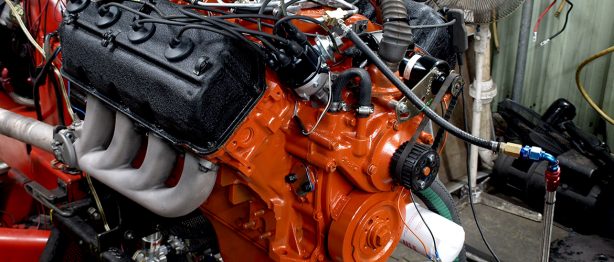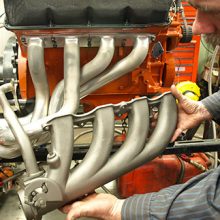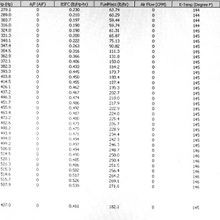Manifold Mystery Tour – Dodge Exhaust Manifolds on Trial – 426 Street HEMI®
426 Street HEMI® Exhaust Manifolds: How Efficient Are They?
The 426 Street HEMI is such a legend among gearheads, there’s just as much misinformation surrounding it as there is fact, maybe more. Stick around the bench races long enough and you’ll hear it all. Like this one: “Those huge cast iron cylinder heads are the heaviest in the industry.” But whip out an industrial scale and you’ll see that each bare 1966-’71 head comes in at 58.2 pounds. Guess what, that’s a full ten pounds less than a typical Chevrolet LS6 454 iron cylinder head (68.2 pounds)!
A close look at any vintage 426 HEMI head reveals how Tom Hoover and his Gen II (1964-’71) HEMI design team thoughtfully trimmed mass at every opportunity – without sacrificing strength. This becomes especially obvious when you compare a 426 head to a typical 1951-’58 (Gen I) Chrysler HEMI head. The Gen I heads pack lots of unnecessary mass, especially at the ends, where the flattened surfaces look sanitary but are nearly one inch thick. But still, at 65 pounds bare, the 392 HEMI head is – you guessed it – 3.2 pounds lighter than the 454 Bowtie!
Another persistent Street HEMI rumor is that the factory-installed cast iron exhaust manifolds are supposed to kill horsepower and should be replaced immediately for best performance. True, the 1966 Street HEMI evolved out of the 1964 Race HEMI and was certainly de-tuned (cam, compression and induction) for use on Main Street, U.S.A. So while the semi-hand built, limited production 1964 and ’65 Race HEMI cars were fitted with exotic two-piece tube steel headers (with durable cast iron flanges), the reality of mass production, noise restrictions and cost forced the use of cast iron exhaust manifolds on the more civilized Street HEMI.
But again, a close look reveals large, unobstructed passages with minimal pinch points. They’re not hastily cobbled blobs of iron. Beyond that, the rest of the Street HEMI’s full-length dual exhaust system was also maximized for efficient flow. The HEMI-only head pipes are connected by an “H” tube to enhance low end torque and 2-1/2-inch tubing replaces the 2-inch material used on 440 Magnums. Dodge even worked with O.E. exhaust component supplier Walker Industries to give the HEMI a unique set of big-in / big-out mufflers. These so-called “HEMI mufflers” quickly became the hot trick for 383 and 440 owners looking for extra sizzle.
To learn the truth about Street HEMI exhaust manifolds, we hooked up with Donnie Wood and his team at R.A.D. Auto Machine in Ludlow, Massachusetts. They had a freshly rebuilt 1966 426 Street HEMI on the dyno that was built to bone-stock specifications. There was no stroker crank hiding inside, the stock 10.25:1 compression was retained, and a pair of Scott Smith / Harms Automotive Carter 625s sit on the un-modified dual-quad intake manifold. The only deviation from 1966 is the use of a Mopar® Performance solid lifter cam (PN 4529316), which is a copy of the same cam Dodge used on 1968-’69 Street HEMIs. It’s got a little bit more lift and duration (0.484/0.475 lift, 284/284 degrees of duration) than the milder 1966-’67 Street HEMI unit (0.467/0.473 lift, 276/276 degrees of duration).
With the stock exhaust manifolds in place, the “orange monster” made 494.4 horsepower at 5,950 rpm and 498.3 lb.-ft. of torque at 4,500 rpm. The horsepower result sheds light on another popular bit of Street HEMI lore, its 425 horsepower factory rating; was it realistic? Though the insurance industry watchdogs weren’t yet at full howl when the Street HEMI hatched in 1966, Dodge wanted to keep a lid on blatant bragging and decided to claim the HEMI’s output at 5,000 rpm, where it wasn’t yet in “full bloom”. By 6,000 or 6,500 rpm, where most HEMI racers up-shifted to the next gear, horsepower was considerably more. In our test, the HEMI was making 459.3 at 5,000 rpm, 34.3 more than the factory rating at the same rpm.
Dodge wasn’t alone in this little game of bluff the regulators. The top-tier 1966 L72 Corvette 427 debuted with a 450 horsepower rating. It even said so on the air cleaner sticker. But after the first few weeks of production, a revised air cleaner sticker proclaimed 425 horsepower – despite zero changes elsewhere.
Getting back to our comparison test, a pair of Hooker Super Competition headers – quite similar to those used by racers since the sixties – was installed on our Street HEMI and horsepower surged to 521.3 at 6,000 rpm while torque nudged up to 502.7 lb.-ft. at 3,300 rpm. The gains appear modest (27.2 horsepower and a mere 4.1 lb.-ft. of torque), but a look at the rpm shows that the headers brought the arrival of peak torque down from 4,500 to 3,300 rpm, nearly 1,000 rpm sooner. That could equal a car length advantage for headers with equal traction.
So there it is, headers “only” unleashed an extra 27.2 horsepower and had a minimal impact on peak torque. The big lesson learned is that the iron Street HEMI exhaust manifolds are not mere place holders, ripe for replacement at the first opportunity. In fact, they’re pretty good. In the next installment of the Manifold Mystery Tour series, we’ll explore the headers-vs.-manifolds controversy on other legendary Dodge muscle era legends. We’ve got a bunch lined up for you, so stay tuned!








0 Comments